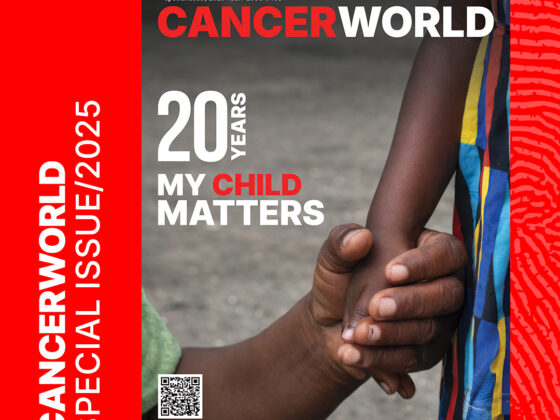Over the past 10 years, immune checkpoint inhibitors (ICIs) have transformed the therapeutic landscape of cancer, becoming standard treatments for metastatic melanoma, renal cell carcinoma, head and neck cancer, and non-small cell lung cancers (NSCLC).
“ICIs have revolutionised care in cancers that were previously untreatable or highly resistant to conventional treatment, such as metastatic melanoma, a disease that previously had very few therapy options,” says David Pinato, Director of Developmental Cancer Therapeutics at Imperial College London. “In other conditions, like NSCLC, combining ICIs with chemotherapy has broadened the reach of standard therapies and dramatically improved prognosis.”
ICIs take advantage of components of the body’s immune system to fight cancer. The drugs work by releasing natural ‘brakes’ that prevent the immune system from attacking tumour cells, targeting inhibitory checkpoint pathways including programmed cell death receptor-1 (PD-1), programmed cell death ligand-1 (PD-L1), and cytotoxic T-lymphocyte-associated molecule-4 (CTLA-4). Under normal circumstances these immune checkpoints allow the immune system to respond to infection while protecting tissues from harm. However, when people develop cancer, expression of immune-checkpoint proteins by cancer cells disrupts the antitumour immune response, favouring growth and expansion of cancer cells. “The rationale behind ICI therapy is simply that targeting these regulatory or inhibitory pathways enhances immune activity against tumour cells,” explains Pinato.
The US and European regulators, FDA and EMA, have approved three different ICI categories – PD-1 inhibitors (nivolumab, pembrolizumab, and cemiplimab), PDL-1 inhibitors (atezolimumab, durvalumab and avelumab) and a CTLA-4 inhibitor (ipilimumab) for treating a variety of cancers.
These can deliver truly remarkable results, such as those demonstrated in the Checkmate 067 study, published in the New England Journal of Medicine, in 2019, which showed that the combination of nivolumab plus ipilimumab in patients with metastatic melanoma resulted in overall survival of 52% at five years.
“The figures we’re seeing in modern trials are unprecedented. Put into context, prior to ICIs the median survival for metastatic melanoma was around six months. The five-year results demonstrate that long-term survivorship is becoming an option,” says Pinato.
However, unfortunately only a proportion of patients experience benefit, ranging from around half in melanoma to one-quarter in liver cancer, with no benefit currently shown for patients with ovarian and pancreatic cancers.
“When making decisions for the patient in front of us, it can be really tough to know who to treat”
“While certain cancers benefit more than others, at the moment we have an incomplete understanding on an individual basis of who is likely to benefit from ICIs. When making decisions for the patient in front of us, it can be really tough to know who to treat,” says Pinato. “Research is desperately needed to develop a better understanding of the host’s immune landscape and tumour microenvironment. This would help to identify those most likely to benefit, and develop strategies to improve response.”
Three separate studies, published in February 2023, provide new insights into strategies that might be used to increase ICI efficacy, ultimately allowing treatment to benefit more cancer patients. The studies suggest that eating a Mediterranean diet, boosting CD5+ dendritic cells and mitigating the impact of use of antibiotics in the year preceding the start of treatment will all enhance responses to ICIs.
Influence of antibiotics
Preclinical studies have shown that specific species of bacteria in the gut can have a direct impact on the effectiveness of ICIs, and on immune-related toxicities. Since exposure to antibiotics can alter the gut microbiome, there has been growing interest in evaluating the impact of antibiotic exposure on response to checkpoint inhibitors.
In a study published in the Journal of Clinical Oncology, 24 February, Lawson Eng from the Princess Margaret Cancer Center, Toronto, and colleagues, evaluated the impact of antibiotic exposure prior to starting treatment with ICIs on overall survival among patients with cancer.
For the population-level retrospective cohort study, the Canadian team identified 2,737 adult cancer patients aged 65 years or older who, between June 2012 and October 2018, initiated treatment with ICIs. The cohort was then linked to other healthcare databases to obtain antibiotic prescription claim data for up to one year prior to treatment, with multivariable Cox models used to evaluate associations between exposure and overall survival. Antibiotic information obtained included: the name, class, estimated treatment duration, and number of doses, with separate analyses undertaken according to ‘exposure windows’ of up to one year and within 60 days of starting treatment with the checkpoint inhibitors.
The most common cancer sites in the study were lung (53%), melanoma (34%), and genitourinary cancers (renal 7% and bladder 3%), with nivolumab and pembrolizumab being the most common ICIs used initially. Altogether 1,627 patients (59%) were found to have received antibiotics within one year of commencing ICI therapy – 532 of them (19% of the total) within 60 days.
Results show that any antibiotic exposure up to one year before ICI treatment was associated with worse overall survival in comparison to those taking no antibiotics (adjusted hazard ratio [aHR] 1.12; 95%CI 1.12–1.23, P=0.03). For those taking the antibiotic class fluoroquinolones, overall survival results were even more pronounced (aHR 1.26; 95%CI 1.13–1.40, P<0.001 for those taking fluoroquinolones in the last year, and aHR 1.20; 95%CI 0.99–1.45, P=0.06 for those taking fluoroquinolones in the last 60 days).
For patients with renal cancers, a notable finding was that the CTLA-4 blocker ipilimumab improved overall survival in patients who had been exposed to antibiotics in the preceding year (aHR 0.92; P=0.03).
“These results suggest that clinicians should potentially consider antibiotic exposure in the past year when starting patients on ICIs,” write the authors.
“The authors suggest strategies might be introduced to alter gut microbiomes in patients previously exposed to antibiotics”
Commenting on the finding that fluoroquinolones had the strongest adverse impact on overall survival, they write that this antibiotic is well known to alter levels of many gut microbiota, including Faecalibacterium, Ruminococcus, Bifidobacteria and Alistipes, all of which have been shown to affect ICI responses. “Fluoroquinolones also have immunomodulatory activities that can influence cytokine release and the immune response, which in turn may affect response to ICI,” they write.
Prior to starting ICIs, the authors suggest, strategies might be introduced to alter gut microbiomes in patients previously exposed to antibiotics. These include prebiotics (nondigestible substrates favouring growth of specific gut microbial species), probiotics (foods containing beneficial bacteria) and use of faecal microbiome transplantation.
In an accompanying editorial, Pinato and Alessio Cortellini, also from Imperial College London, suggest that, in the absence of consolidated microbiome modulations, one option would be to switch antibiotic-exposed patients to chemo-immunotherapy combinations – a therapeutic modality less sensitive to the impact of antibiotics. A further layer of complexity that will need to be taken into consideration, they add, is the plethora of other potentially immunomodulatory concomitant medications, such as corticosteroids and proton pump inhibitors, which might have an impact on immunotherapy efficacy through dynamic modulation of the gut microbiome independent of antibiotic use.
“The key objective now is to demonstrate whether reversal of antibiotic-mediated gut dysbiosis might prove to be beneficial in abolishing [these] increasingly well-characterized mechanisms of ICI resistance,” write Pinato and Cortellini.
Benefits from Mediterranean diet
In a study published in JAMA Oncology, 16 February, Rinse Weersma and colleagues from the University of Groningen, the Netherlands, and King’s College London, set out to explore whether diet was associated with tumour response to ICIs in patients with advanced melanoma.
Motivation for the study came from findings that the abundance of several gut bacteria predictive of ICI response were associated with diet. “For example, dietary fibre is degraded to short-chain fatty acids (SCFAs) by bacteria, such as bifidobacteria, and high fibre intake and faecal SCFA concentrations have been associated with response in mice and ICB treated patients,” write the authors. The study set out to look at the role of whole-food dietary patterns in patients, going beyond single-nutrient whole-food patterns.
For the PRIMM study, diet and clinical data were prospectively collected from 91 patients with advanced melanoma (44 from the Netherlands and 47 from the UK) who received ICIs (a PD-1 inhibitor, a CTLA-4 inhibitor, or both), between 2018 and 2021. Using food frequency questionnaires, the team undertook a dietary pattern analysis to explore whether any specific dietary patterns were associated with response to ICIs.
They found that a Mediterranean dietary pattern, which is high in whole grains, fish, nuts, fruit and vegetables, produced the highest overall response rate and highest progression-free survival at 12 months, and that a Mediterranean diet with a score of 5 (representing the maximum adherence to the diet) was associated with the highest probability of response.
Dietary intervention come with practical considerations, including how long it would take to induce changes in the gut microbiome
“To prove the relevance of diet we need randomised controlled trials with hard endpoints such as progression free survival and a long follow-up and sufficient sample size,” says Laura Bolte, the dietitian on the study in a pod-cast published on the JAMA Oncology site.
The current data, she adds, represents the long-term dietary patterns of patients prior to their diagnosis of melanoma, raising questions around how feasible it would be to change patients’ diets following a diagnosis of cancer. Any dietary intervention would come with practical considerations, including how long the intervention would take to induce changes in the gut microbiome.
Also speaking on the podcast, Geke Hospers, a professor in medical oncology at University of Groningen, said that in place of diet, one approach might be to directly manipulate the gut microbiome. But many questions remain unanswered, including what would be the optimal microbiome to optimise ICI responses and whether ‘good bacteria’ would survive and stay?
Boosting CD5+ dendritic cells
In a study published in Science, February 17, Eynav Klecjevsky and colleagues, from Washington University School of Medicine at St Louis, Missouri, have discovered that the difference between people who do and do not respond to immunotherapy may have to do with an immune cell known as CD5+ dendritic cells, because they bear the protein CD5 on their outer surfaces.
By analysing data from The Cancer Genome Atlas, a public database with information on 20,000 tumours representing 33 cancer types, the team discovered that patients with skin, lung, bone, breast and cervical cancers did better when exposed to ICIs if they had higher levels of CD5+ dendritic cells in their tumours.
“Our data identify CD5 on dendritic cells as a new potential target for enhancing response rates among patients undergoing treatments”
Next, they showed that selective deletion of CD5 expression in dendritic cells prevented an efficient response to ICI therapy in tumour-bearing mice, resulting in defective immune rejection of tumours.
“Our data provide insight into how immunotherapies like ICB [ICIs] work and identify CD5 on DCs [dendritic cells] as a new potential target for enhancing response rates among patients undergoing treatments,” write the authors.
As part of the study the team discovered that the immune protein IL-6 increases the amount of CD5+ dendritic cells.
Measuring the amount of CD5+ dendritic cells inside tumours, they add, could be used to assess which patients are most likely to respond to ICIs.
The unifying factor of these three studies, says Pinato, is to look at more tailored ways to broaden the benefits of immunotherapy. “We are transitioning from an era of infancy in immunotherapy with the way forward being to become more targeted, and consider the individual host and tumour microenvironment. Ultimately, we hope that taking a holistic approach will help us bridge the gap between responders and non-responders and enable everyone to benefit,” says Pinato.











